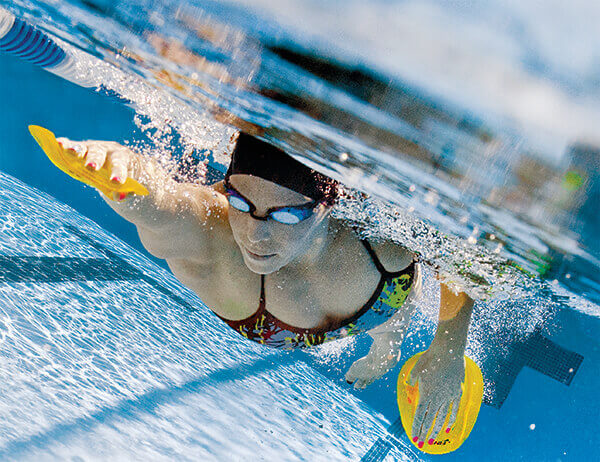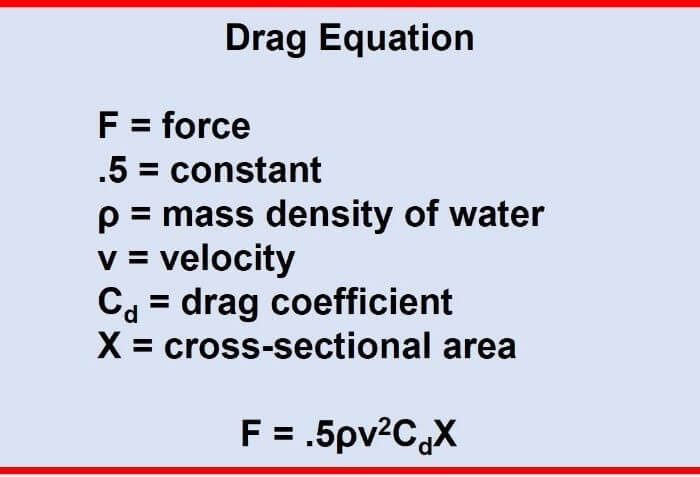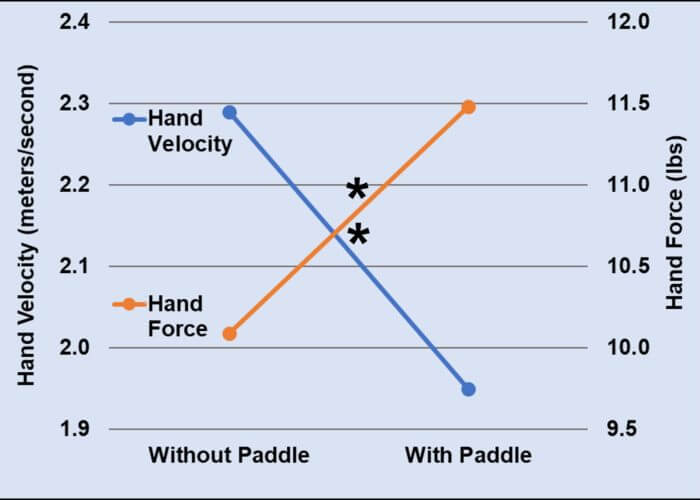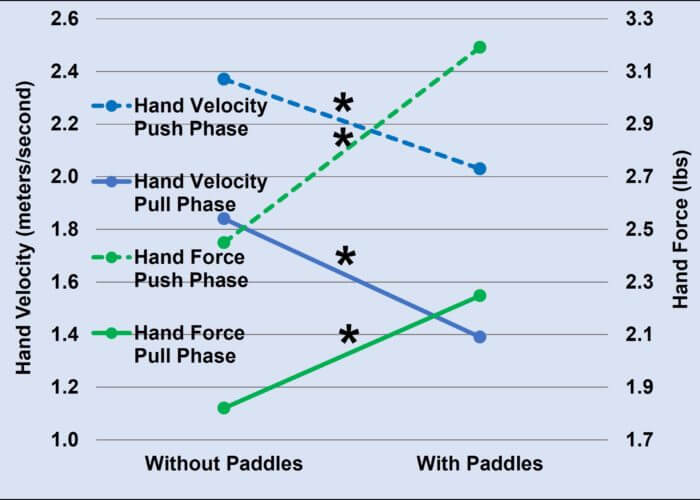Tech Tuesday: The Effect Of Hand Paddles On Swimming Performance (Data Included)

Technique: The Effect Of Hand Paddles On Swimming Performance
BY ROD HAVRILUK, Ph.D.
Swimming with hand paddles is often promoted for benefiting strength, technique and swimming velocity, while also being criticized for causing shoulder pain. However, research shows that neither the commonly stated advantages or disadvantages of paddles are necessarily true without adequate control.
Paddles can increase strength, improve technique and increase swimming velocity. Paddles can also help a swimmer avoid shoulder pain. In all cases, a swimmer must control the paddles by using sight (visually) and feel (kinesthetically). The shape and size (area) of hands and paddles are relevant to controlling paddles.
THE SHAPE AND AREA OF HANDS AND PADDLES
The shape (as measured by the drag coefficient, Cd) of a hand and a paddle is usually different. The Cd of a flat plate (similar to a paddle) was reported to be about 1.3 (NASA, 2022). The Cd of different hand orientations at different points in a stroke cycle (based on computational fluid dynamics) was reported to be 0.6 to 2.4, with an average that was a little less than a paddle (Bilinauskaite, 2013).
The area (X) of a hand and a paddle is usually different. The area of a hand is typically less than 200 sq cm. The area of a paddle can be more than 400 sq cm. Swimmers often wear paddles that are about twice as big as their hand.
The net effect of wearing a paddle, based on the shape and area, is a considerably greater value for the product of Cd and X than a hand alone.
THE EFFECT OF PADDLES ON STRENGTH
Based on the difference of a paddle in shape (Cd) and area (X), the drag equation shows that there will be more propulsive force (F—i.e., to increase strength), providing there is not an offsetting decrease in velocity (v). That means that a swimmer must move the paddle at a relatively fast velocity (near the velocity without a paddle) to achieve a strength effect.

Photo Courtesy:
However, research shows that swimmers often have a slower hand velocity with paddles than without, and with only a small increase in hand force. For example, the graph in Fig. 1 shows that while wearing paddles, male swimmers decreased hand velocity and increased force less than two pounds (Tsunokawa, 2018).

Photo Courtesy:
FIG. 1 > This graph shows a significant decrease in hand velocity and a significant increase in hand force. Asterisks indicate significant differences.
More specifically, hand velocity decreased on both the pull and push phases for female swimmers using paddles, as shown in Fig. 2 (Gourgoulis, Aggeloussis, Vezos, Kasimatis, 2008). When paddles were worn, hand velocity decreased and hand force increased in both the pull and push phases.

Photo Courtesy:
FIG. 2 > This graph shows a significant decrease in hand velocity and a significant increase in hand force using paddles in both the pull and push phases. Asterisks indicate significant differences.
It is not surprising that a study concluded that “paddle training is probably not as effective to improve swimming-specific strength as often believed” (Takagi, et al., 2021). Another recent study concluded that paddles had “little, if any, strength benefit” (Wirth, 2022). A swimmer must move a paddle almost as fast as a hand to achieve a strength benefit.
THE EFFECT OF PADDLES ON TECHNIQUE
In addition to slowing hand velocity, research shows that the distance a hand moves is less with than without a paddle. When wearing paddles, the horizontal distance that a hand moved was found to be 11 cm (more than 4 inches) or 21% less than the total underwater hand distance (Gourgoulis, 1992). Another study found that the distance decreased by 10 cm or 15% (Alves, 2006.)
Since a paddle makes movement of a hand more noticeable, a swimmer can control it. For example, a swimmer can feel if a paddle moves backward a horizontal distance that is equal to the distance without a paddle.
THE EFFECT OF PADDLES ON SWIMMING VELOCITY
Although swimmers usually move the hand more slowly and through a shorter distance with hand paddles than without, the research shows that swimmers usually swim faster with paddles than without paddles (Fig. 4). In five studies (Gourgoulis, Aggeloussis, Vezos, Kasimatis, 2008; Tsunokawa, 2018; Gourgoulis 2006; Barbosa, 2013; Gourgoulis, Aggeloussis, Vezos, Antoniou, 2008), swimmers swam faster with paddles. In two studies (Lopez, 2012; Barbosa, 2020), swimmers had no significant difference in swimming velocity with and without paddles.

Photo Courtesy:
FIG. 4 > This graph shows the results from seven studies that compared swimming velocity with and without paddles. Asterisks indicate significant differences.
THE EFFECT OF PADDLES ON SHOULDER INJURY
Research shows that the effect of paddles on pain is as controversial as any of the benefits. Early research found that “the use of hand paddles exacerbates shoulder pain” (Richardson, 1980). Subsequent research stated that there is “no association between shoulder pain and…hand paddle usage” (Stocker, 1995). Rather than address whether or not using paddles causes pain, it is more helpful to swimmers to improve technique to avoid pain whether or not paddles are worn.
Typically, swimmers stress the shoulder by completing the freestyle arm entry approximately parallel to the water’s surface, whether or not paddles are worn. A level arm entry makes the initial downward arm motion stressful on the shoulder as well as nonproductive for propulsion. A downward angle both relieves stress on the shoulder and positions the arm to generate propulsion.
SUMMARY
Research shows that there is no guarantee that hand paddles will improve strength, technique or swimming velocity or increase shoulder pain. However, if swimmers attend to specific visual and kinesthetic information, paddles can help swimmers increase strength, make technique changes, swim faster and avoid injury.
Before each training session, a swimmer must remember to:
• See and feel a paddle move at a fast velocity to gain strength
• Feel a paddle push back as far as a hand to maintain technique
• Feel that he/she is using paddles to swim faster
• See and feel a downward angle on the arm entry to avoid shoulder pain.
Dr. Rod Havriluk is a sport scientist and consultant who specializes in swimming technique instruction and analysis. His newest ebooks in the “Approaching Perfect Swimming” series are “Optimal Stroke Technique” and “Swimming Without Pain,” and are available at swimmingtechnology.com. Contact Rod through info@swimmingtechnology.com.




noice, very helpful!
GOOD POINTS